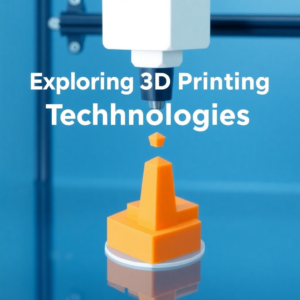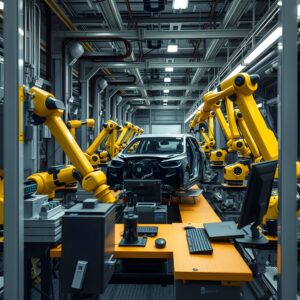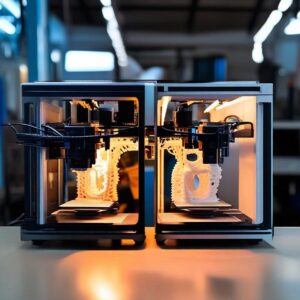Exploring the Environmental Impact of 3D Printing

Discover how 3D printing impacts the environment in both positive and negative ways. Learn about sustainable materials, reduced waste, energy consumption, and the future of eco-friendly additive manufacturing.
The Promise and Pitfalls of 3D Printing
The rise of 3D printing , also known as additive manufacturing, has revolutionized industries ranging from aerospace to healthcare. Its ability to create complex objects layer by layer from digital designs has made manufacturing faster, more efficient, and more affordable. But as the technology gains traction across the globe, questions about its environmental impact are becoming increasingly pertinent.
3D printing has often been lauded for its eco-friendly benefits. Unlike traditional manufacturing methods, which often waste materials during production, 3D printing uses only the amount needed to create an object—minimizing waste and promoting material efficiency. Moreover, the decentralized nature of 3D printing allows for on-site production , reducing the need for shipping and its associated carbon emissions. These characteristics position 3D printing as a promising tool in the fight against climate change.
However, like most technologies, 3D printing is not without its drawbacks. Concerns have been raised about energy consumption, the environmental impact of certain materials, and the potential for microplastic pollution. The rapid growth of additive manufacturing has outpaced the development of proper recycling systems and sustainable material sourcing, raising questions about its long-term ecological sustainability.
As the technology matures, it’s critical to evaluate both its positive and negative effects on the planet. How does 3D printing stack up against traditional methods in terms of its environmental footprint? Can additive manufacturing truly solve some of our sustainability challenges, or does it create new environmental dilemmas? Answering these questions is key to understanding the role of 3D printing in shaping an eco-friendly future.
This article takes an in-depth look at the environmental impact of 3D printing, exploring both the benefits and challenges in implementing it as a sustainable manufacturing practice. We’ll also discuss ongoing innovations in materials and explore how businesses and governments can promote greener 3D printing practices.
The Positive Environmental Benefits of 3D Printing
3D printing has gained praise as an environmentally friendly manufacturing method , particularly when compared to traditional production processes like subtractive manufacturing or mold casting. Its unique design and production model allow for a myriad of sustainability benefits that are worth exploring.
One of the most significant environmental advantages of 3D printing is its ability to reduce waste . Traditional manufacturing often involves cutting, drilling, or shaping raw materials, processes that can leave behind large amounts of scrap. In contrast, additive manufacturing builds objects layer by layer based on a digital design, using only the materials needed for the finished product. This precision minimizes waste drastically, especially when working with expensive materials like titanium or carbon fiber.
Another major benefit of 3D printing is localized manufacturing , which reduces the carbon footprint associated with transporting goods over long distances. Because 3D printing allows for the production of parts and components on-site or closer to their final destination, there’s less reliance on global supply chains and shipping. This capability became especially valuable during the COVID-19 pandemic, when 3D printing enabled local production of critical items like face shields, bypassing the need for international shipments.
The technology also supports innovations in sustainable materials. Many 3D printers now use biodegradable filaments like PLA (polylactic acid), which is derived from renewable sources such as cornstarch or sugarcane. Recycled materials, including plastics from discarded items, can also be repurposed for 3D printing, contributing to a circular economy. In industries like fashion and consumer goods, organizations are developing fully recyclable filaments to further reduce environmental impact.
Furthermore, 3D printing encourages on-demand production , which eliminates overproduction and excess inventory waste. Instead of manufacturing large quantities of items upfront and risking unsold goods sitting in warehouses, companies can print items only as orders are received—significantly reducing resource consumption and storage requirements.
Lastly, 3D printing contributes to energy efficiency by enabling the production of lightweight yet strong components, particularly in aerospace and automotive industries. By reducing the weight of parts like airplane brackets or car structures, these industries can lower fuel consumption and operational emissions, driving long-term environmental benefits.
The Environmental Challenges of 3D Printing
While 3D printing offers several environmental advantages, it is not without its shortcomings. A closer look at its negative environmental consequences reveals significant concerns about energy consumption, material waste, and pollution, all of which must be addressed for the technology to achieve its full sustainability potential.
One of the most pressing issues is energy consumption. Many 3D printers, particularly industrial-grade ones, require high amounts of electricity to operate. The process of melting or fusing materials (such as plastics or metals) often involves energy-intensive processes like laser sintering, which can consume more power than traditional manufacturing methods. For example, a study published in The Journal of Industrial Ecology found that in some cases, the energy required for 3D printing was 50 to 100 times higher per kilogram of material processed compared to injection molding.
The environmental impact of 3D printing materials also raises concerns. While some 3D printers use biodegradable or recyclable materials, a significant number still rely on petroleum-based plastics like ABS (Acrylonitrile Butadiene Styrene), which are neither biodegradable nor easy to recycle. Improper disposal of these materials contributes to microplastic pollution , further exacerbating environmental degradation.
Another issue is the lack of scalable recycling systems for printed materials. Current recycling processes for 3D printing waste are expensive and often impractical for small businesses or individual creators. Failed prints, excess material from supports, and outdated prototypes often end up in landfills, where they’re unlikely to degrade for hundreds of years, adding to the global plastic pollution crisis.
Air quality is also a concern. Melted thermoplastics used in desktop and industrial 3D printers often release volatile organic compounds (VOCs) and ultrafine particles (UFPs), which can harm indoor air quality and potentially affect respiratory health. As 3D printing becomes more widespread in homes and workplaces, these emissions may raise environmental and health risks that require mitigation.
Finally, affordability and accessibility remain barriers to proper sustainability practices. While sustainable filaments and energy-efficient 3D printers are available, they are often more expensive than standard options. This cost disparity slows the widespread adoption of greener solutions, as businesses and hobbyists may prioritize affordability over sustainability.
Ongoing Innovations to Mitigate Environmental Impacts
Despite its challenges, 3D printing technology is evolving rapidly, with new innovations aimed at reducing its environmental footprint. Researchers, developers, and manufacturers are collaborating to create more sustainable practices and materials that address key ecological concerns. These innovations are setting the stage for greener applications of additive manufacturing.
One promising development involves the creation of biodegradable and plant-based materials. Filaments like PLA have gained popularity due to their renewable origins and compostability under specific conditions. Other biodegradable materials, including wood-fused composites and algae-based plastics, are being refined for use in 3D printing. These materials make eco-friendly 3D printing more accessible across industries such as consumer goods, packaging, and architecture.
Recycling initiatives are also on the rise. Startups and organizations are working to develop systems where failed prints and excess filament waste can be shredded and reused as printing material. Closed-loop systems—where waste is recycled back into the production process—are being explored, particularly in industries like automotive and healthcare. For example, a company in the Netherlands has created filament made entirely from discarded PET bottles.
Efforts to improve energy efficiency in 3D printers are gaining momentum as well. Innovative hardware designs and new manufacturing methods—such as low-temperature sintering —aim to reduce the energy consumption of industrial-grade machines. Solar-powered 3D printers and printers optimized for renewable energy resources are also in the works, aligning with global efforts to reduce dependency on fossil fuels.
Emerging design software is playing a role in enhancing the sustainability of 3D printing by enabling optimized geometries that reduce material usage and energy requirements. For instance, generative design tools use algorithms to create lightweight structures while maintaining strength and stability. These designs not only require less material but also have downstream benefits, such as reducing transportation weight and fuel consumption.
Finally, education and policy advocacy are key areas of focus. Governments and industry leaders are beginning to draft regulations promoting sustainable 3D printing practices , including material certifications and recycling mandates. Educational institutions are also teaching sustainability principles as part of 3D design curricula, equipping future creators with the tools and knowledge to prioritize eco-friendly solutions.
Comparing 3D Printing with Traditional Manufacturing
Understanding the environmental impact of 3D printing requires comparing it with traditional manufacturing methods such as injection molding, machining, and mass production. While 3D printing excels in certain areas, its overall sustainability varies depending on the specific application and industry.
One of the clearest advantages of 3D printing is its ability to reduce waste , whereas traditional manufacturing often produces large volumes of excess material during cutting or molding. For example, machining a metal part from a solid block can result in a material loss of 60% to 70%, compared to additive manufacturing, which uses only the amount needed. In industries using expensive resources like titanium, this efficiency is especially valuable.
On the other hand, traditional manufacturing methods remain more energy-efficient for mass production. Processes like injection molding use consistent molds to produce thousands of identical items with minimal energy per part. In contrast, 3D printing is more suitable for low-volume or custom production , as each individual print requires significant setup time and energy.
Material use also differs significantly. Traditional manufacturing uses a wide range of well-established materials that are easier to source, recycle, and repurpose. In comparison, many of the plastics used in 3D printing are single-use and lack comprehensive end-of-life solutions, leading to a higher risk of waste accumulation. However, innovations in sustainable 3D printing filaments are narrowing this gap.
From a lifecycle perspective, 3D printing has the advantage of reducing transportation emissions through localized production , something traditional manufacturing often cannot achieve. Businesses can simply distribute design files and print them closer to their destination, eliminating the need for shipping bulky materials or goods across continents.
When evaluating environmental impact, the most practical solution may involve integrating both manufacturing methods based on the specific needs of a project. For high-volume production, traditional methods remain more scalable. For custom, on-demand, or prototype designs, 3D printing offers clearer environmental benefits, especially as sustainable practices continue to improve.
The Future of 3D Printing and Sustainability
As industries strive to combat climate change and meet sustainability goals, 3D printing is poised to play a vital role in shaping a greener future. The trajectory of additive manufacturing shows promise in overcoming current environmental challenges while driving innovation in eco-conscious processes and materials.
The development of closed-loop recycling systems is one of the most exciting prospects for sustainable 3D printing. By ensuring that waste products, failed prints, and discarded prototypes are fully recyclable, industries can achieve true circularity in their production cycles. Advances in material science will likely result in high-performance, recyclable filaments designed to reduce waste at every stage of the manufacturing process.
Energy efficiency remains a top priority for the future of 3D printing. Emerging technologies like binder jetting and room-temperature sintering are being refined to minimize energy-intensive operations, making 3D printing a viable alternative to deeply entrenched traditional methods. Integration with renewable energy sources, such as solar or wind power, will further reduce the carbon footprint associated with the technology.
The adoption of biomaterials and nature-inspired design principles will expand significantly in the coming years. Filaments derived from algae, fungi, or plant waste could become mainstream in applications like construction and consumer goods. Additionally, the design of objects optimized for minimal material use, such as bio-mimicry-inspired geometries , will support efficient resource management.
Collaboration between researchers, governments, and private companies will play a key role in aligning 3D printing with global sustainability goals. Policy interventions, such as mandatory recycling or the implementation of carbon-neutral production targets, are expected to drive a more eco-friendly approach. Moreover, as consumer awareness grows, demand for transparency and sustainable practices will push businesses to prioritize environmentally conscious 3D printing.
The future of sustainability and 3D printing ultimately lies in balancing growth with responsibility. By innovating greener materials, embracing energy-efficient practices, and increasing public and private collaboration, the industry can transform 3D printing from a disruptive technology into a pivotal force for environmental change.
Moving Toward Sustainable Additive Manufacturing
3D printing has proven itself as a transformative force in modern manufacturing, offering both significant environmental benefits and challenges. Its ability to minimize material waste, enable localized production, and support sustainable design innovations has won praise from environmental advocates. However, concerns over energy consumption, recycling inefficiencies, and microplastic pollution remain pressing issues that must be addressed.
The future of 3D printing is undeniably intertwined with sustainability. Through ongoing material innovation, optimized energy use, and global policy initiatives, the technology can evolve into an even greener alternative to traditional manufacturing. As industries continue to adopt additive manufacturing, balancing growth and environmental responsibility will be crucial in shaping its long-term impact.
In the coming years, collaborative efforts between businesses, researchers, and governments will determine the role 3D printing plays in advancing sustainability. With the right investments in eco-friendly practices, additive manufacturing has the potential to become not only a driver of innovation but also a champion for a cleaner, more sustainable world.
FAQs
1. Is 3D printing environmentally friendly?
3D printing has both positive and negative environmental effects. On the positive side, it minimizes material waste, enables localized production to reduce transportation emissions, and supports the use of sustainable materials like biodegradable PLA. However, challenges such as energy consumption, non-biodegradable plastics, and inadequate recycling systems raise environmental concerns. With innovation, 3D printing is moving toward becoming more eco-friendly.
2. How does 3D printing help reduce waste compared to traditional manufacturing?
Traditional manufacturing methods, like subtractive machining, often waste significant amounts of raw materials during production via cutting, milling, or drilling. In contrast, 3D printing is additive —objects are created layer by layer using only the materials required. This precision eliminates material waste, making 3D printing a much more resource-efficient process, especially in industries like aerospace where raw materials are costly.
3. Does 3D printing use recyclable materials?
Yes, many materials used in 3D printing are recyclable, though it depends on the specific material. Biodegradable filaments such as PLA (polylactic acid) are sourced from renewable materials like cornstarch, making them eco-friendly. Some companies also recycle used plastics, failed prints, and scraps to create new filaments. However, widespread recycling systems for 3D printing waste are still under development.
4. What are the main environmental challenges of 3D printing?
The main challenges include:
- Energy consumption : Industrial 3D printers can require significant electricity, especially during high-temperature processes like laser sintering.
- Plastic waste : Many 3D-printed items use non-biodegradable materials like ABS, which can contribute to pollution.
- Air quality concerns : Certain 3D printing methods release volatile organic compounds (VOCs) and ultrafine particles (UFPs), which can harm both the environment and human health without proper ventilation.
- Recycling limitations : The recycling infrastructure for failed prints and wasted materials is underdeveloped.
5. How does 3D printing compare to traditional manufacturing in terms of carbon footprint?
3D printing generally has a lower carbon footprint for small-scale and custom production. Unlike traditional manufacturing, it eliminates the need for molds, reduces waste, and enables localized production , which decreases emissions from shipping and transportation. However, for large-scale production, traditional manufacturing can be more energy-efficient per unit, especially when using established, high-throughput methods like injection molding.
For other insights and projects, be sure to explore our Key Technologies in 3D Printing or Uses of 3D Printing column




